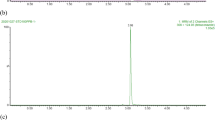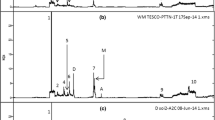Abstract
Piperine is a bio-active compound found in pepper, including Piper nigrum L. and P. longum L. It has a strong, pungent flavour and several pharmacologic benefits. However, the risks of piperine have not yet been characterized. In this study, piperine in black pepper and some selected foods was determined to characterise the risk of exposure to piperine. Piperine in black pepper, curry and noodle was analysed by high-performance liquid chromatography–ultraviolet detection, which was validated through the measurement of performance parameters. The mean concentrations of piperine in black pepper, powdered curry, retorted curry, instant noodle and cup noodle were 4,418, 28, 3.4, 4.3 and 4.2 mg/100 g, respectively. The estimated dietary exposure to piperine was 123.66 μg/kg body weight/day, and the margin of exposure calculated by the no-observed-adverse-effect level of piperine, was 162. The piperine from food does not cause an adverse health effect to the public in Korea.


Similar content being viewed by others
References
American Spice Trade Association (ASTA). Method 12(1): 52–53 (1997).
Anagha R, Anuradha U, Arvind M. HPTLC method for analysis of piperine in fruits of Piper species. J. planar. chroma. 24: 57–59 (2011)
Bang JS, Choi HM, Sur B-J, Lim S-J, Kim JY, Yang H-I, Yoo MC, Hahm D-H, Kim kS. Anti-inflammatory and antiarthritic effects of piperine in human interleukin 1β-stimulated fibroblast-like synoviocytes and in rat arthritis models. Arthritis. Res. Ther. 11: 1–9 (2009).
Chandra P, Pandey R, Srivastva M, Rameshlumar KB, Kumar B. Quantitative determination of chemical constituents of Piper spp. using UPLC-ESI-MS/MS. Ind. Crop. Prod. 76: 967–976 (2015)
Da Silva Cardoso V, Ribeiro de Lima CA, Freire de Lima ME, Dorneles LEG, Teixeira Filho WL, Lisboa RS, Da silva Guedes JrD, Direito GM, Danelli MDGM. Oral piperine administration to broiler checkens. Ciencia. Rural. 39:1521–1526 (2009)
Dogra RK, Khanna S, Shanker R. Immunotoxicological effects of piperine in mice. Toxicol. 196: 229-236 (2004)
Enviornmental Protection Agency (EPA), Section 13: Quantitative risk assessment calculations, sustainable futures/p2 framework manual 2012 EPA-748-B12–001, Environmental Protection Agency (EPA) Washington, DC, USA. pp.11 (2012)
Ferreira C, Soares DC, Barreto-Junior CB, Nascimento MT, Lima LF, Delorenzi JC, Lima ME, Atella GC, Folly E, Carvalho TM, Saraiva EM, Silva LHP. Leishmanicidal effects of piperine, its derivatives, and analogues on Leishmania amazonensis. Phytochemistry 72: 2155-2164 (2011)
Gaikar VG, Raman G. Process for extraction of piperine from piper species. Google Patents (2002)
Gorgani L, Mohammadi M, Najafpour GD, Nikzad M. Sequential microwave-ultrasound-assisted extraction for isolation of piperine from black pepper (Piper nigrum L.). Food Bioproc. Tech. 10: 2199–2207 (2017a)
Gorgani L, Mohammadi M, Najafpour GD, Nikzad M. Piperine-the bioactive compound of black pepper: from isolation to medicinal formulations. Compr. Rev. Food Sci. F. 16: 124–140 (2017b)
Hertwig C, Reineke K, Ehlbeck J, Knorr D, Schlter O. Decontamination of whole black pepper using different cold atmospheric pressure plasma applications. Food Control 55: 221-229 (2015)
Hu S, Ao P, Liu D. Pharmacognostical studies on the roots of Piper nigrum L. III: Determination of essential oil and piperine. Acta. Hortic. 426: 179-182 (1996)
The Joint FAO/WHO Expert Committee on Food Additvies (JECFA). Safety evaluation of certain food additives and contaminants. Sixty-fifth meeting of the Joint FAO/WHO Expert Committee on Food Additvies, WHO Food Additives: 56. IPCS, WHO, Geneva (2006)
Jin MJ, Han HK. Effect of piperine, a major component of black pepper, on the intestinal absorption of fexofenadine and its implication on food-drug interaction. J. Food Sci. 75: H93-H96 (2010)
Khajuria, A., Thusu, N., Zutshi, U. Piperine modulates permeability characteristics of intestine by inducing alterations in membrane dynamics: influence on brush border membrane fluidity, ultrastructure, and enzyme kinetics. Phytomedicine 9: 224-231 (2002)
Khajuria, A., Zutshi, U., Bedi, K., Permeability characteristics of piperine on oral absorption: an active alkaloid from peppers and a biovailability enhancer. Indian J. Exp. boil. 36: 46-50 (1998)
Ko JM. A study on quantitative method of piperine in pure ground black pepper. J. Food Hyg. 10: 169-174 (1995)
Korea Centers for Disease Control and Prevention (KCDC). The seventh Korea national health & nutrition examination survey VII-2. Osong (Korea), Korea Centers for Disease Control and Prevention (2016) https://www.khidi.or.kr/kps/dhraStat/result1?menuId=MENU01652&year=2016
Korea Centers for Disease Control and Prevention (KCDC). The seventh Korea national health & nutrition examination survey VII-2. Osong (Korea), Korea Centers for Disease Control and Prevention (2017) https://www.khidi.or.kr/kps/dhraStat/result1?menuId=MENU01652&year=2017
Mujumdar AM, Dhuley JN, Deshmukh VK, Raman PH, Naik SR. Anti-inflammatory activity of piperine. Jpn. J. Med. Sci. Biol. 43: 95-100 (1990)
Mukherjee PK (2002). Quality control of herbal drugs, Business Horizons: New Delhi.pp.755–760
Parthasarathy VA, Chempakam B, Zachariah TJ. Chemistry of spices. London: CABI (2008)
Pradeep C, Kuttan G. Effect of piperine on the inhibition of lung metastasis industry of induced B16F-10 melanoma cells in mice. Clin. Exp. Metastasis 19: 703-708 (2002)
Pruthi J. Quality assurance in spices and spice products, modern methods of analysis. New Delhi, India: Allied Publishers Ltd (1999)
Rao PJ, Kolla SD, Elshaari F, Elshaari F, Awamy HE, Elfrady M, Singh R, Belkhier A, Srikumar S, Said AR, Dhopoide SJ, Ramanujam R, Elbarassi I, Peela LT, Argi A. Effect of piperine on liver fuction of CF-1 albino mice. Infect. Disord. Drug Targets 15: 131-134 (2015)
Sabina EP, Souriyan ADH, Jackline D, Rasool MK. Piperine, an active ingredient of black pepper attenuates acetaminophen-induced hepatotoxicity in mice. Asian Pac. J. Trop. Med. 3: 971-976 (2010)
Santosh MK, Shaila D, Rajyalakshmi I, Rao IS. RP-HPLC Method for determination of piperine from Piper longum Linn, and Piper nigrum Linn. E. J. Chem. 2: 131-135 (2005)
Shingate PN, Dongre PP, Kannur DM. New method development for extraction and isolation of piperine from black pepper. . Int. J. Pharm. Sci. 4: 3165-3170 (2013)
Sunila E, Kuttan G. Immunomodulatory and antitumor activity of piper longum Linn. and piperine. J. Ethnopharmacol. 90: 339–346 (2004)
Tasleem F, Azhar I, Ali Sn, Perveen S, Mahmood ZA. Analgesic and anti-inflammatory activities of Piper nigum L. Asian Pac. J. Trop. Med. 7: 461–468 (2014)
Ternes W, Krause EL. Characterization and determination of piperine and piperine isomers in eggs. Anal. Bioanal. Chem. 374: 155-160 (2002)
Thiel A, Buskens C, Woehrle T, Etheve S, Schoenmakers A, Fehr M, Beilstein P. Black pepper constituent piperine: genotoxicity studies in vitro and in vivo. Food Chem. Toxicol. 66: 350-357 (2014)
Vijayakumar R, Surya D, Nalini N. Antioxidant efficacy of black pepper (Piper nigrum L.) and piperine in rats with high-fat-diet-induced oxidative stress. Redox Report 9: 105-110 (2004)
Funding
This research was supported by the Basic Science Research Program through the National Research Foundation of Korea (NRF) funded by the Ministry of Education (NRF-2017R1D1A1B03036312).
Author information
Authors and Affiliations
Corresponding author
Additional information
Publisher's Note
Springer Nature remains neutral with regard to jurisdictional claims in published maps and institutional affiliations.
Rights and permissions
About this article
Cite this article
Lee, JG., Kim, AY., Kim, DW. et al. Determination and risk characterisation of bio-active piperine in black pepper and selected food containing black pepper consumed in Korea. Food Sci Biotechnol 30, 209–215 (2021). https://doi.org/10.1007/s10068-020-00860-1
Received:
Revised:
Accepted:
Published:
Issue Date:
DOI: https://doi.org/10.1007/s10068-020-00860-1




